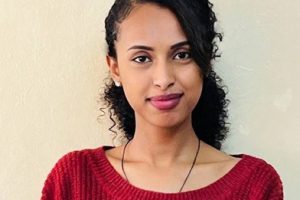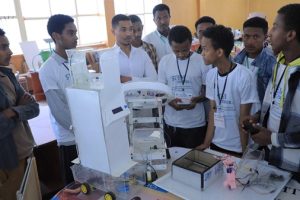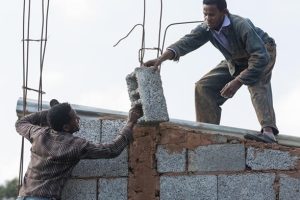
Qarree (virgins) 
Kalaalee, Abbaa Gadaa wives
Oromo believe in Waaqa Gurraacha-the Holy and Mighty, creator, universal and master of every creature. They believe that Waaqa is pure and unique that He has the power to do and undo every nature and should be praised by its creature. And the religion is Waaqeffanna- worshiping the monotheistic and unique God.
The major material by which they praise God is the nature. For this reason, the slogan of their religion is “Uumamaan Uumaa galateeffanna” that literally means: “We praise the Creator by His creation.”
As well, as the French Missionary Father Martial de Salviac said in his book: An Ancient People: Great African Nation: The Oromo, published in Paris in 1901, the Oromo are not fetishists. They believe in Waaqa Tokko, unique, universal, creator and master. They see His manifestations in the great forces of the nature, without mistaking them for Him.
The Oromo hate worshiping idols. Even more, they have neither elevated any temple to Waaqa, nor to awulia-an idol. “They repudiate all anthropomorphic representation of the Divinity. Their temple, which is the universe with the star-studded arch; their altar, the surface of the earth; their sacrifices are always innocent, even the one which we see to sanctify the cradle of humanity that is to say the first fruits fields and the primes of the herd.
They ask only of the giants of the forest or of the most beautiful neighboring tree of their village to shade with its luxuriant tress, their prayers and their immolations.”
Therefore, the Oromo give thanks to their Waaqa-God whom they individually call more intimately Waaqayyoko-my good God-through Irreechaa ceremony which is part of their religion Waaqeffanna. Irreechaa is religious thanks giving ritual and prayers to Waaqa-God.
Irreechaa is led by Abbaa Muudaa- Anointed ing father. The Qaallus-wise people and forecasters of future events-determine the Irreechaa day. That day is considered as the day of happiness, holiness, peace, and love for which the people give thanks and pray to Waaqa Gurraacha [Gurraacha means black; the Black God]-the Holy and Mighty, creator, universal and master of every creature. He is uninvestigated and cannot be investigated.
Likewise, Alemayehu Haile argues in his book Gada System: Politics of the Tulama Oromo published in 2014 that Irreechaa ceremony is beyond a religious ceremony.
At a ritual, Oromo world view is clearly revealed. Participants hold dark green fresh grass and pray to Waaqa. In Waaqeffanna: Waaqa-God and water are regarded as the sources of live. They are also pure. “This takes back one to the history of the ancient god Osiris of the Nile Valley.” It was agricultural cult of the dying and resurrecting spirit of plant life.
Although Oromo religion has some characteristics of the Cushitic peoples, it is not totally the same. Oromo believe in one supernatural being-Waaqa Gurraacha. Its tradition of believing in one God and the cult of Osiris has originated from the ancient Nile civilization, as Alemayehu stated.
And there are two types of Irrechaa ceremonies based on its purpose and its recital place. It is performed either at a riverside or at the top of a mountain on the eve of Birraa (autumn) and Arfaasa (spring) respectively in the Oromo religion Waaqeffanna. The river or a lake side thanks giving rite is called Irrechaa Malkaa while the mountain or hill top thanks giving is Irreechaa Tulluu.
Irrechaa Malkaa is performed in the last week of September to praise God for the end of the rainy season and the beginning of the spring.
Attendants glorify and pray Waaqayyo. The main contents of the prayers are the wish for peace, social order, happiness and love among fellow people, fertility, surplus production and the like.
The participants arrangement is based on the Oromo values called ‘safu’. The front liners are the virgins. They differ from other women by their hairstyles and dressing. They shave a circle on their skull at the back center called qarree. They open the ceremony which has been started three days before by the Abbaa Muudaa.
The girls are followed by the Kalaalee or Cifiree- mothers of the Abbaa Gadaa- Gada leaders. Kalaalees simply comb their gray hairs and put raw butter in the center of their skulls. They are on the same line with the wives of the Abbaa Gadaas to demonstrate the hierarchical respect to the leadership.
Wives of the Abbaa Gadaas wear caaccuu on their necks from the back that falls to their fronts down to their breasts. Caaccuu is a kind of handmade ornament from snail shell sawed on animal skin. It represents the power of Waaqa that creates something important in the water and the organ of the female as well as her wish to have a son-prayer for fertility.
Next to the Abbaa Gadaa wives, Haadha Siinqees, women with sticks, come. These are married women having siinqees-thinner sticks which look like that of the Abbaa Gadaa sticks in their hands. The bride’s mother gives siinqe to her daughter on marriage day to protect her from any harm. If she picks up the siinqee even her husband has no right to touch her against her will for any reason.
Then the Abba Gadaas and Lubas follow the women with sticks. Luba is a former Abbaa Gadaa, eight years older than the incumbent Abbaa Gadaa. They have kallacha on their foreheads.
Kallacha is made up of metal and thunderstorm magnet. It looks like a phallus. It represents fertility and cleanliness of the Abbaa Gadaa as he is circumcised. And circumcision is one of the criteria to be an Abbaa Gadaa. It also demonstrates the leadership hierarchy and the throne.
As well, they have long sticks called Horooroo in their left hand and dark green fresh grasses in their right hands. Horooroo is made from a unique tree called Harooressa. At its top, the Horooroo resembles phallus, and at its bottom, it looks like an external female genital. They hold it to show that they are married and pray for fertility. It is the Moses stick of the Oromo, in general.
Behind the Abbaa Gadaas, the Qeerroo-youth and adults march. They chant and mime after the leaders in the front line.
At last, the dominant colors of the clothes worn by the Irreechaa attendants are three: black, red and white like the Gadaa System Flag in this order. Especially, the clothes of the leaders are decorated with these three colors.
Baqqala Faajjii are the clothes worn by Abbaa Gadaas. They are made of cotton, and they are used as the symbol.
The black represents holiness, neatness, being uninvestigated and uniqueness as it stands for Waaqa. And red represents blood, patriotism and love for the people while the white demonstrates death, breakdown of the bones, decomposition of human and life after death-ekera.
The Ethiopian Herald October 4, 2019
BY DIRRIBA TESHOME





